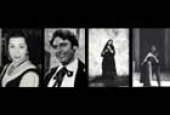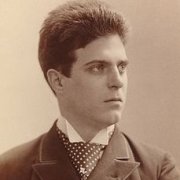BioMascagni showed from his boyhood a remarkable musical talent, and began his studies with a fine Leghorn musician, Alfredo Soffredini. His father was a baker and dreamed of a career as a lawyer for his son, but following the good reception obtained by Mascagni’s first compositions was persuaded to allow him to study music at the Milan Conservatoire, where his teachers included Amilcare Ponchielli and Michele Saladino, and where he shared a furnished room with his fellow-student Giacomo Puccini. He was of a rebellious nature and intolerant of discipline, and in 1885 he left the Conservatoire to join a modest operetta company as conductor. He became part of the Compagnia Maresca and, together with his future wife, Lina Carbognani, settled in Cerignola (Apulia) in 1886, where he formed a symphony orchestra.
Here Mascagni composed at a single stroke, in only two months, the one-act opera Cavalleria rusticana, based on the short story by Verga, which was to win him the first prize in the Second Sonzogno Competition for new operas. The innovative strength of the opera and the resounding worldwide success which followed its first performance (1890, Teatro Costanzi, Rome) marked the beginning of an artistic life rich in achievements and satisfactions, both as composer and as conductor. Among his later compositions the Sonzogno catalogue still lists L’Amico Fritz, Guglielmo Ratcliff, Isabeau, Lodoletta, Le Maschere, Il Piccolo Marat, Silvano and Zanetto.
As a highly talented conductor with a much wider repertoire than is commonly believed, Mascagni was among the first to restore popularity in the Twentieth Century to operas by Mozart (Don Giovanni) and Rossini (Mosé, Semiramide), and to make known in Italy the music of Tchaikovsky and Dvorák.
Admired by such musicians as Verdi and Mahler and an authentic “star” of his time, of which he was recognised as one of the major protagonists, Mascagni died at the age of 82 in a room of the Hotel Plaza in Rome, where he had spent the last years of his life.
Gallery
 The second edition of the score of Cavalleria rusticana. On the cover are the first interpreters: Gemma Bellincioni and Roberto Stagno
The second edition of the score of Cavalleria rusticana. On the cover are the first interpreters: Gemma Bellincioni and Roberto Stagno The first edition of the score of Le Maschere (1901)
The first edition of the score of Le Maschere (1901) Poster by Giuseppe Palanti for the first Italian performance of Isabeau (1912, La Scala, Milan)
Poster by Giuseppe Palanti for the first Italian performance of Isabeau (1912, La Scala, Milan) Some great interpreters of Cavalleria rusticana: Giulietta Simionato, Mario Del Monaco, Fiorenza Cossotto, José Cura and Violeta Urmana
Some great interpreters of Cavalleria rusticana: Giulietta Simionato, Mario Del Monaco, Fiorenza Cossotto, José Cura and Violeta Urmana Luciano Pavarotti and Mirella Freni in L'amico Fritz
Luciano Pavarotti and Mirella Freni in L'amico Fritz
Operas-
MASCAGNI Pietro
Ave Maria per voce e orchestra da camera
Symphonic
00h 03' 00"
-
MASCAGNI Pietro
Ave Maria per voce, arpa e archi
String
00h 03' 00"
-
MASCAGNI Pietro
Cavalleria rusticana
Operas
01h 20' 00"
-
MASCAGNI Pietro
Cavalleria rusticana, addio alla madre
Symphonic
00h 04' 00"
-
MASCAGNI Pietro
Cavalleria rusticana, brindisi
Symphonic
00h 03' 00"
-
MASCAGNI Pietro
Cavalleria rusticana, duetto Santuzza-Alfio
Symphonic
00h 05' 00"
-
MASCAGNI Pietro
Cavalleria rusticana, duetto Santuzza-Turiddu
Symphonic
00h 08' 00"
-
MASCAGNI Pietro
Cavalleria rusticana, intermezzo
Symphonic
00h 03' 00"
-
MASCAGNI Pietro
Cavalleria rusticana, introduzione e coro
Symphonic
00h 08' 00"
-
MASCAGNI Pietro
Cavalleria rusticana, preghiera
Symphonic
00h 06' 00"
-
MASCAGNI Pietro
Cavalleria rusticana, preludio
Symphonic
00h 06' 00"
-
MASCAGNI Pietro
Cavalleria rusticana, racconto di Santuzza
Symphonic
00h 04' 00"
-
MASCAGNI Pietro
Cavalleria rusticana, scena di Alfio
Symphonic
00h 04' 00"
-
MASCAGNI Pietro
Cavalleria rusticana, siciliana
Symphonic
00h 02' 00"
-
MASCAGNI Pietro
Cavalleria rusticana, stornello di Lola
Symphonic
00h 01' 00"
-
MASCAGNI Pietro
Danza esotica per orchestra
Symphonic
00h 08' 00"
-
MASCAGNI Pietro
Guglielmo Ratcliff
Operas
02h 00' 00"
-
MASCAGNI Pietro
Guglielmo Ratcliff, sogno
Symphonic
00h 03' 00"
-
MASCAGNI Pietro
Il piccolo Marat
Operas
02h 10' 00"
-
MASCAGNI Pietro
Intermezzo da "Cavalleria Rusticana"
Chamber
00h 03' 00"
-
MASCAGNI Pietro
Isabeau
Operas
01h 45' 00"
-
MASCAGNI Pietro
Isabeau, intermezzo
Symphonic
00h 06' 00"
-
MASCAGNI Pietro
L'amico Fritz
00h 00' 00"
-
MASCAGNI Pietro
L'amico Fritz, aria di Beppe - atto I
Symphonic
00h 03' 00"
-
MASCAGNI Pietro
L'amico Fritz, aria di Beppe - atto III
Symphonic
00h 02' 00"
-
MASCAGNI Pietro
L'amico Fritz, aria di Fritz
Symphonic
00h 05' 00"
-
MASCAGNI Pietro
L'amico Fritz, aria di Suzel - atto I
Symphonic
00h 03' 00"
-
MASCAGNI Pietro
L'amico Fritz, aria di Suzel - atto II
Symphonic
00h 03' 00"
-
MASCAGNI Pietro
L'amico Fritz, aria di Suzel - atto III
Symphonic
00h 02' 00"
-
MASCAGNI Pietro
L'amico Fritz, duetto della Bibbia
Symphonic
00h 05' 00"
-
MASCAGNI Pietro
L'amico Fritz, duetto delle ciliegie
Symphonic
00h 07' 00"
-
MASCAGNI Pietro
L'amico Fritz, duetto Suzel-Fritz
Symphonic
00h 05' 00"
-
MASCAGNI Pietro
L'amico Fritz, intermezzo
Symphonic
00h 04' 00"
-
MASCAGNI Pietro
L'amico Fritz, preludietto
Symphonic
00h 04' 00"
-
MASCAGNI Pietro
Le Maschere
Operas
02h 00' 00"
-
MASCAGNI Pietro
Le Maschere, furlana
Symphonic
00h 04' 00"
-
MASCAGNI Pietro
Le Maschere, inno a Rosaura
Symphonic
00h 04' 00"
-
MASCAGNI Pietro
Le Maschere, sinfonia
Symphonic
00h 09' 00"
-
MASCAGNI Pietro
Lodoletta
Operas
01h 40' 00"
-
MASCAGNI Pietro
Lodoletta, serenata delle fate
Symphonic
00h 03' 00"
-
MASCAGNI Pietro
Sancta Maria per voce e orchestra
Symphonic
00h 04' 00"
-
MASCAGNI Pietro
Serenata per tenore e archi
String
00h 05' 00"
-
MASCAGNI Pietro
Silvano
Operas
01h 20' 00"
-
MASCAGNI Pietro
Silvano, barcarola
Symphonic
00h 06' 00"
-
MASCAGNI Pietro
Sinfonia in do minore per orchestra da camera
Symphonic
00h 10' 00"
-
MASCAGNI Pietro
Sinfonia in fa maggiore per orchestra da camera
Symphonic
00h 31' 00"
-
MASCAGNI Pietro
Zanetto
Operas
00h 43' 00"
-
MASCAGNI Pietro
Zanetto, coro d'introduzione
Symphonic
00h 04' 00"


 The second edition of the score of Cavalleria rusticana. On the cover are the first interpreters: Gemma Bellincioni and Roberto Stagno
The second edition of the score of Cavalleria rusticana. On the cover are the first interpreters: Gemma Bellincioni and Roberto Stagno The first edition of the score of Le Maschere (1901)
The first edition of the score of Le Maschere (1901) Poster by Giuseppe Palanti for the first Italian performance of Isabeau (1912, La Scala, Milan)
Poster by Giuseppe Palanti for the first Italian performance of Isabeau (1912, La Scala, Milan) Some great interpreters of Cavalleria rusticana: Giulietta Simionato, Mario Del Monaco, Fiorenza Cossotto, José Cura and Violeta Urmana
Some great interpreters of Cavalleria rusticana: Giulietta Simionato, Mario Del Monaco, Fiorenza Cossotto, José Cura and Violeta Urmana Luciano Pavarotti and Mirella Freni in L'amico Fritz
Luciano Pavarotti and Mirella Freni in L'amico Fritz